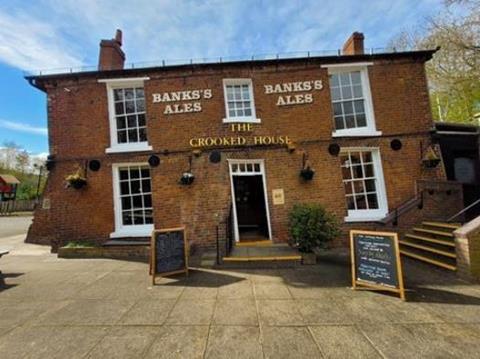The sorry story of the Crooked House pub tells us that sometimes maybe we have to let a building go, writes Anna Beckett

Following a court hearing, the owners of the ill-fated Dudley pub “The Crooked House” were last week ordered to rebuild. In case you’ve missed the story, the pub caught fire last summer after a change in management and was hastily demolished once the fire was out. The series of events was a little questionable to say the least.
I’ve followed this story closely, not just because it’s interesting in terms of how we treat our existing buildings, but also because I grew up about 10 minutes away. I remember going there with family members that are no longer with us. I remember my sister falling off the climbing frame in the pub garden. I remember a particularly disorientating experience when I had first started drinking as a teenager. It’s a part of my childhood; a building that I haven’t been to for years but that I always thought would be there.
The building itself was fascinating; built in the 1700s as a mill house it became a pub around 1830 and started to subside not long after. The subsidence was dramatic, a result of mining activity in the area, causing a level difference of just over a metre across the building.
In the 1940s it was saved from demolition due to safety concerns, when a local brewery bought the building and undertook structural works to prevent further movement. Being inside was a strange experience, some things appeared level even though you knew they weren’t, objects appeared to roll uphill and you were never quite sure if you were leaning to one side.
But the thing that made it unique, the crookedness that led to it being named “Britain’s wonkiest pub”, was something that should never have happened. A structural accident. How can that be rebuilt?

Constructing a building with a 15º lean is no easy feat; doing it in brick to meet all current standards is pretty much impossible. It’s likely that additional steel framing will be required inside the building to support the masonry and provide stability. New foundations will be required which will need to be designed in a way to prevent subsidence, particularly as that’s a known issue. All of that will require the use of significantly more resources than the original building would have required.
But surely some of the original brickwork can be reused? Well, reuse of brickwork from the building would certainly have been possible if it had been considered before the building was bulldozed. Buildings and facades are often taken down and rebuilt for many different reasons, but in most of those cases the bricks are carefully removed and catalogued. If you’ve seen photos of what was left of the Crooked House you’ll know that it is pretty much a pile of rubble. I’m sure it will be possible to retrieve some bricks, but the number is likely to be limited.
If the original fabric isn’t being used and the way in which the building is constructed will be different, what is going to be the same? There’s a collective nostalgia that makes us want to hold on to things from our past - I’m sure there are plenty of people out there who, like me, felt outraged about the loss of this building despite not having been there in years. But at a time when we understand the carbon implications of construction, when we know that resources are limited and we need to use them wisely, is replicating something that’s been lost really the right thing to do?
I don’t think that the pub should have been knocked down. I think efforts could have been made to save it following the fire, but it they weren’t. There are lessons to be learnt about how we protect the buildings that we love, particularly the more unusual ones, but we also need to ensure that we’re being sensible about the way we use the resources that we have. However emotional we feel, we need to find the right balance between preserving a building and preserving a memory. Sometimes maybe we have to let the building go.
> Also read: The loss of the Crooked House pub reveals that built heritage is about a lot more than buildings
Postscript
Anna Beckett is an associate at Buro Happold
















2 Readers' comments